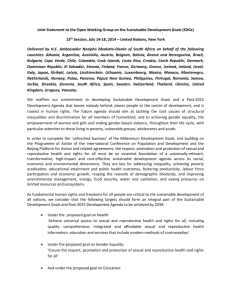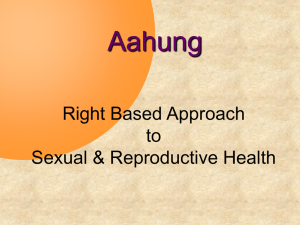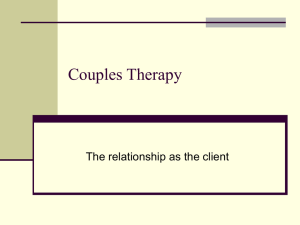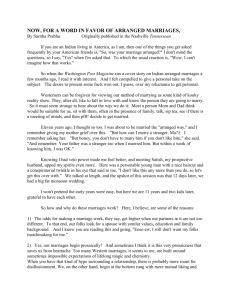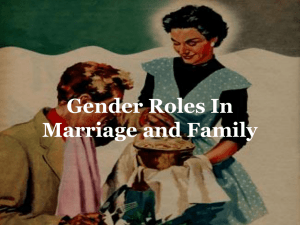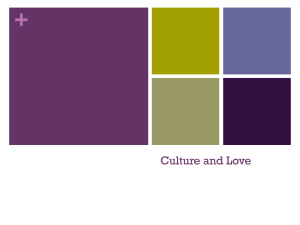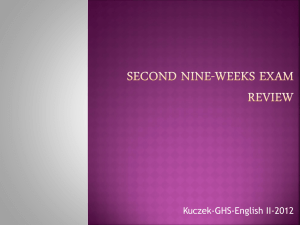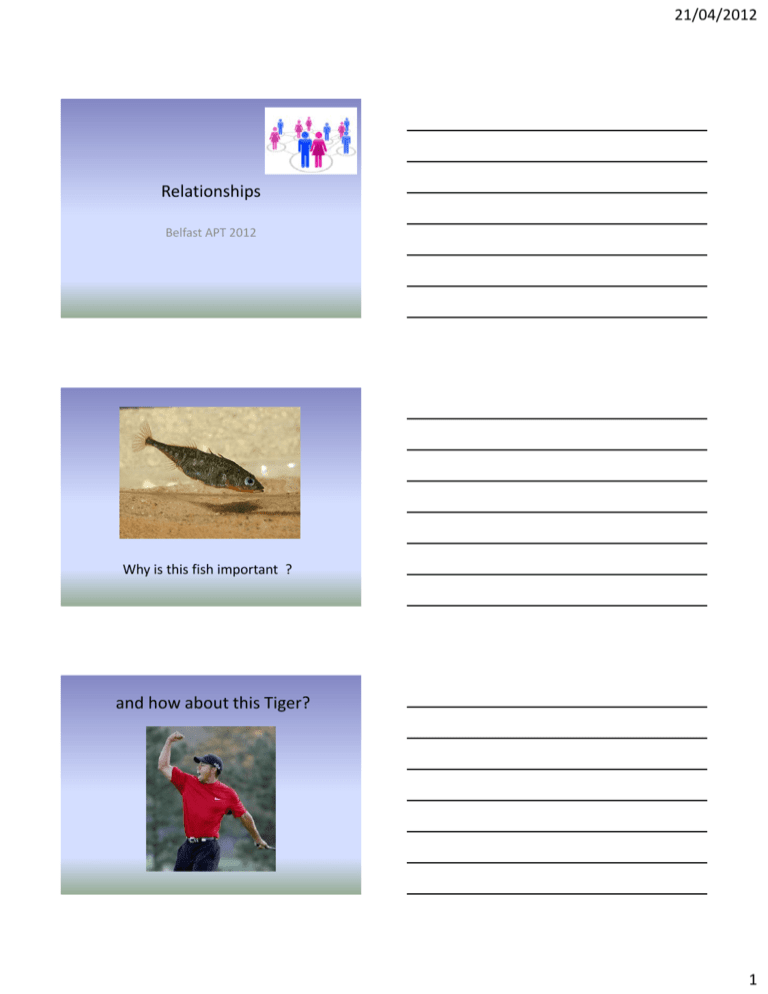
21/04/2012
Relationships
Belfast APT 2012
Why is this fish important ?
and how about this Tiger?
1
21/04/2012
Questions on PSYA3
Questions are marked out of 24 marks - 8 A01
(Description ) and 16 A02 (Evaluation and analysis)
• Essay questions can be divided into 2 or 3 sections.
• Sections of a question CAN be drawn from different
parts of the Specification
• You need to do roughly twice as much evaluation as
description
• So : keep description short and snappy (the 5 bullet
point theory)
Evaluation ....
• Is mainly of theories or explanations
• Evidence for and evidence against.....
• Evaluation of research studies CAN gain credit but
only if you make the implications for the theory
explicit
• Different approaches can be used to evaluate
each other
• In order to achieve reasonable or effective A02
marks , you must include reference to
approaches, issues and debates
Formation , maintenance and
breakdown of relationships
2
21/04/2012
Filter model (Kerckhoff and Davis 1962)
Formation of relationship takes place through 3 filters :
1. Social demographic : the social filter - who we get to meet.
We meet people who live near, go to school / college / work
with us. They usually come from a similar social
background and class. This group makes up the ‘ field of
availables ‘
2. Similarity : the individual filter - relationship is more likely to
develop / progress if we share interests, attitudes and
hobbies - ‘field of desirables’
3. Complementary needs : the dyadic filter - for a relationship
to carry on , the ability to meet each others emotional needs
/ want similar things becomes important
Evidence....
• Kerckhoff and Davis (1962 ) : student couples completed
questionnaires about their attitudes/ personality over a 7
month period . Up to about 18 mths, similar attitudes were
important in staying together . After 18mths meeting each
others emotional needs became most important
• Sprecher (1998) : couples in long term relationships have
more similar social backgrounds than couples who split up
• The social demographic filter has become less important for
several reasons : CMC allows us to meet and get to know
people from different places/ backgrounds so the field of
‘availables ‘ is much wider.
• Filter model ignores attachment style and early experience
Reward/ need satisfaction theory
• Relationships are formed with people who meet our
social needs and provide rewards
• Common social needs include : self esteem ( to feel
good about ourselves), dependency ( be looked
after) dominance, sexual needs ( Argyle )
• Foa and Foa (1974) : 6 kinds of relationship rewards
including practical (money, presents and help ) and
emotional rewards ( status , and feeling loved )
• Relationships also provide rewards in the form of
shared activities and time spent together.
3
21/04/2012
Evidence and evaluation
• This theory has close links to the behavioural approach with
its emphasis on rewards and reinforcements.
• Reward/ need theory is supported by evidence . Long term,
happy relationships meet many of the needs of the two
people involved. In contrast, unhappy relationships involve
unmet needs (Smith and Mackie 2002)
• The idea of rewards underpins other important theories (
e.g. social exchange theory and equity theory )
• This is a westernized theory. In many parts of the world
where arranged marriages are common, rewards may be less
important
Maintenance and breakdown
Key questions
• How do people run their relationships ?
• What factors influence them to stay or leave
when things get sticky ?
• Two economic theories – exchange and equity.
Both assume that we run relationships like
bank accounts.
• Both can be applied to maintenance &
breakdown but they must be shaped
Social Exchange theory ( Homans 1961)
•Relationships involve rewards and costs
• We seek relationships which provide maximum
rewards and minimum costs ( the minimax principle )
•We compare our current relationship with those in
the past and our general expectation of rewards ( CL)
•We also compare our current relationship with
possible alternatives ( Cl Alt )
•If we expect more rewards elsewhere we may leave !
Version 1.0
Copyright © 2010 AQA and its
licensors. All rights reserved.
4
21/04/2012
Evidence
• As a relationships develop rewards increase but so do
costs ( Argyle )
• Many people stay in unrewarding relationships
because of investments.
• Rhatigan and Axholm ( 2006) studied women in a
refuge and found that they stayed because of
investments which had been put in and could not be
got back out such as time, emotional investment
• SET views people as basically selfish. Equity theory
argues that we prefer fairness not selfishness
• This is a westernized theory. Many arranged marriages
cannot be ended at will
Equity theory ( Walster 1978)
• Agrees that people weight up reward and costs
BUT argues that we expect our relationship to be
fair
• People want to get back roughly as much as they
put in
• A feeling of inequity ( unfairness) makes the
‘loser’ feel dissatisfied
• They will try to restore equity by putting in less or
getting their partner to put in more
• If this isn’t successful, the relationship will break
down
Evidence for equity theory
Van Yperen and Buunk 1990 studied 368 married and cohabiting
couples and measured two variables :
• Feelings of equity in the relationship
• Feelings of satisfaction with the relationship one year later
• Higher equity at time 1 led to more satisfaction 1 year later
• Correlation was .44 ( highly significant ) for women and .20
for men
De Maris ( 2007) studied 1500 American couples and found that
inequity was the most important factor in predicting who
would split up
• Equity is also very important in lesbian couples
5
21/04/2012
Commentary
• Both economic theories take a cognitive – social
approach to relationships, focusing on what people
think, believe, tell themselves
• They view people as rational, autonomous, able to
weigh up rewards, costs, needs and make choices to
stay or go
But relationships are often’ determined’ by
• Family/ friends/ well wishers and cultural norms (non
western cultures )
• Early experiences and childhood attachments
• Predispositions arising from evolution
HUMAN REPRODUCTIVE
BEHAVIOUR
Evolutionary approach
• The relationship between sexual selection and
human reproductive behaviour
• Sex differences in parental investment
Key questions
• How were relationships organised in the
hunter gatherer past ?
• (How ) do these pre-dispositions effect
relationships today ?
6
21/04/2012
Human reproductive behaviour and
natural / sexual selection
•Reproductive behaviours were ‘shaped’ in the
hunter gatherer era (10,000 – 40,000 years ago)
•Behaviours exist today because they brought
reproductive advantages to our ancestors.
•Those who produced more surviving offspring had
greater reproductive success
• The behaviours and bodily features which led to
reproductive success were passed on to their
children who inherited the feature/ behaviour
•This is the process of sexual selection
Version 1.0
Copyright © 2010 AQA and its
licensors. All rights reserved.
2 types of Sexual selection
• Intra-sexual - members of one sex compete
for mates from the other. e. g : large,
aggressive males would beat rivals in fights,
get to mate with more females and would
leave behind more offspring
• Inter sexual - members of one sex choose
partners from the other e.g. females prefer
to mate with males with resources.
The curious example of the
stickleback
7
21/04/2012
Trivers’ parental investment theory
The basis of human reproductive behaviour is
parental investment. Parental investment
consists of mating effort and rearing effort
• Males produce millions of sperm and are fertile
puberty to death
• Female generally produce one ovum per month
and are only fertile for about 30yrs . Pregnancy/
childbirth are time consuming and dangerous.
• This produces different amounts of investment
and different routes to reproductive success for
males and females
Routes to reproductive success
Male investment : small
Female investment : huge
• Mate with as many fertile
women as possible
• Choose young females youth and fertility go
together.
• Behave promiscuously any opportunity for mating
increases reproductive
success
• Ensure the survival of few
precious offspring
• Be choosy : select a mate
who will stay around / input
resources to offspring
• Promiscuity may lead to
pregnancy with no support
to raise offspring who may
not survive
How does this show today ?
8
21/04/2012
Evidence...........
Buss and Schmidt ( 1993) ‘How many sexual
partners would you like over the next 2 yrs/
10 yrs/ lifetime ?
• Over a lifetime women = 4/5, men = 18
• Buss ( 1989) Studies of personal column
adverts and cross cultural studies support the
claim that men and women seek different
qualities in partners
But .....
• This explanation overlooks the role of free will –
many males do not behave promiscuously – and
females do !
• Buss and Schmit’s Sexual Strategies Theory
argues that people use different strategies when
pursuing a short term mate ( one night stand)
and long term partner
• There are alternative, cultural explanations of
these findings. Promiscuity in young men is seen
as laddish-ness but in young women it is frowned
on
EFFECTS OF EARLY EXPERIENCE AND
CULTURE ON RELATIONSHIPS
9
21/04/2012
Key questions.....
The influence of childhood on adult relationships
The influence of culture on relationships
• (How far ) does early experience, upbringing
and culture influence later relationships ?
• Is there a link between childhood attachment
type ( CAT) and adult relationships (AAT )?
Bowlby’s attachment theory
•Differences in relationship ’styles’ originated in
early childhood attachments with carers.
•First relationships provide an ‘internal working
model’ of how relationships operate.
•They also provide us with a characteristic
attachment style ( Ainsworth )
•There are three attachment styles : secure,
insecure ambivalent and insecure avoidant.
•Attachment styles continue to adulthood and
effect adult relationships (the continuity
hypothesis)
Version 1.0
Copyright © 2010 AQA and its
licensors. All rights reserved.
Evidence for continuity...
Hazan and Shaver (1987) Measured responses to a
‘Love Quiz’ in the local paper and found a
relationship between CAT and AAT .
• Secure babies often went on to become secure
adults who found it easy to love and trust
• Avoidant babies became adults who doubted if
love existed and feared involvement and
commitment
• Ambivalent babies became jealous or possessive
adults who were intense and worried about being
abandoned
10
21/04/2012
Evidence against continuity
• Attachment style can change in adulthood in both
directions:
• When major life events occur -such as parental
death or divorce- attachment patterns can
change from secure to insecure Zimmerman
(2000)
• When disrupted early childhood is followed by
later, strong relationships, an insecure
attachment style can develop into earned
security (Rutter, Quinton and Hill 1999)
Relationships in different cultures
Individualistic cultures
Falling in love
Relationships are voluntary
chosen on the basis of love
and attraction. They are
private arrangements
between 2 people
People can choose to live
together
Relationships can be ended if
couples are unhappy
Collectivist cultures.
Learning to love
Marriages are arranged by
relatives or well wishers.
They are alliances between
families.
Partners are chosen for
wealth, profession and
social status of family.
Relationships are viewed as
permanent and divorce can
be difficult / impossible.
Gupta and Singh (1982)
Compared liking and loving in 100 professional Indian
couples, matched for education and all living in Jaipur:
•50 had married for love and 50 had arranged marriages.
•Liking and loving started at high levels in love marriages
but declined rapidly over the first 10 years of the marriage.
• Arranged couples started with lower levels of liking and
love but these increased as the marriage progressed.
• After ten years of marriages, the arranged couples liked
and loved their partners MORE than the chosen couples.
11
21/04/2012
But, it’s more complex than this
Qureshi (1991) : 3 types of arranged marriage :
1. Planned / traditional: Parents choose partners
with little/ no discussion with child ( forced
marriage )
2. Delegation: child explains what kind of partner
they would like and parent / well wishers look for
children from ‘appropriate’ families
3. Joint venture: parents and children are active in
the search for a partner .
Social change
Westernization and globalisation are altering traditional
relationship patterns and expectations .....
Xioahe and Whyte (1990) found that Chinese women who had
chosen their partners were of happier than those in
arranged marriages.
Zaida and Shuraydi (2002) studied 20 2nd generation Pakistani,
Muslim women brought up in Canada. Most disliked the idea
of arranged marriages preferring to choose their own partner.
Both studies show how western cultural views are internalised –
(acculturation. ) Families are often resistant to westernised
leading to a clash of cultures
New cultural arrangements emerging..
Ghuman (1994) studied British and Canadian Sikhs, Hindus and
Muslims . Sikh and Hindu families were more likely to use
delegation or joint venture methods of arranging marriages,
whereas Muslim families preferred traditional arranged
marriages.
Goodwin and Adatia (1997) studied 70 Indian Hindu couples
living in Leicester. Less than 10% had fully arranged marriages.
90% had large element of choice over their partner
12
21/04/2012
That’s all folks
13

